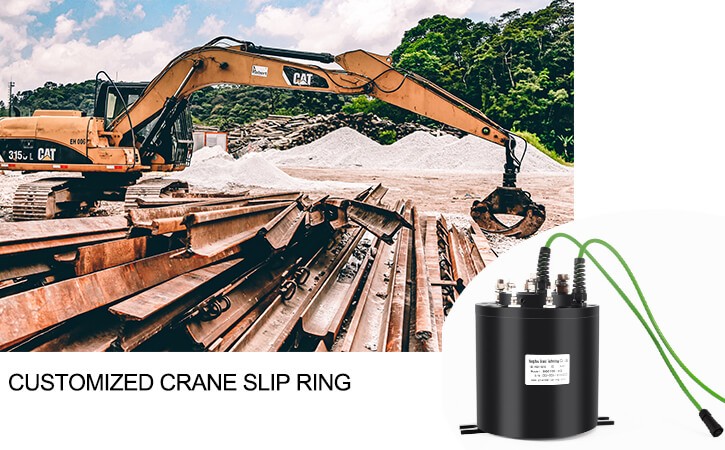Navigating the complex workings and maintenance of marine crane slip rings can be a challenging prospect. This comprehensive guide is designed to shed light on every aspect of these crucial devices. From understanding their fundamental role in marine cranes, exploring the variety of slip ring types, highlighting key design features, demystifying the installation process, emphasizing the vital role of maintenance, and offering guideposts for troubleshooting issues, this article offers a deep dive into the world of marine crane slip rings. Furthermore, it provides useful tips for choosing the right slip ring and takes a speculative look at the technological advancements on the horizon. Whether you’re a technician, buyer, or simply curious, continue reading to broaden your understanding of this indispensable component in marine crane operations.
What are Marine Crane Slip Rings?
Marine Crane Slip Rings serve as an integral component in the operation of marine cranes. They serve as an electromechanical device that allows the transmission of power and electrical signals from a stationary to a rotating structure, such as in a marine crane. These devices, crucial in several marine applications like coil tubing, winches, wirelines, and cranes, are designed to withstand challenging marine conditions. They are engineered to function in extreme environments often encountered in maritime or offshore locations, like subsea oil fields and offshore wind platforms.
Such slip rings are specifically designed, keeping in mind the corrosive nature of sea air and other harsh operational conditions typical of marine environments. The design process will focus on making the slip rings resistant to such conditions to provide optimal performance and longevity.
Maintenance of the slip rings in such challenging environments is critical; yet, it brings numerous challenges due to the very nature of the operational location.
Understanding Marine Cranes and Slip Rings
Detailed Explanation About Marine Cranes and Their Importance
Marine cranes are specifically engineered to operate in challenging maritime and offshore environments, where they play a crucial role in multiple applications, including the shipping, offshore drilling, and construction industries. Their importance stems from their ability to perform vital tasks in these industries, such as loading and unloading cargo, lifting and relocating heavy equipment, servicing offshore installations, assisting with oil drilling operations, and other related activities.
In maritime environments, marine cranes are essential for the efficient and safe operation of ships, barges, and platforms, as they facilitate the transfer of goods and materials from one location to another. In the offshore drilling industry, marine cranes aid in assembling and disassembling drill rigs, moving drilling pipes and other equipment, and ensuring the safety of the crew during maintenance and repair operations. These cranes typically operate under strenuous conditions that make their performance critical to the safety, productivity, and profitability of marine-based businesses.
Types of Marine Cranes
There are several types of marine cranes designed to cater to specific operations and conditions. These include:
- Deck Cranes: Deck cranes are mounted on ships, barges, or offshore platforms and aid in loading and unloading cargo, heavy equipment, and materials. They are versatile, capable of lifting a diverse range of items, and are built to withstand corrosive marine environments.
- Floating Cranes: These cranes are often mounted on pontoons or specialized floating vessels and are mainly used for heavy lifting tasks in shallow waters, construction of bridges, and shipbuilding activities. In some cases, floating cranes may also be utilized for salvaging submerged items, such as sunken ships or lost cargo.
- Harbor Cranes: Harbor cranes are utilized in ports and harbors to load and unload cargo from vessels and assist in other material-handling-related tasks. Their sizes and lifting capacities may vary depending on the needs of a specific harbor.
- Offshore Cranes: Specially designed for the offshore industry, these cranes are installed on drilling platforms, FPSOs (Floating Production, Storage, and Offloading units), and other offshore facilities. Offshore cranes serve various purposes, from handling drilling equipment to assisting in maintenance and repair operations in extreme weather conditions.
Purpose of a Slip Ring in a Crane
The main function of slip rings in marine cranes is to ensure continuous transmission of power and electrical signals between stationary and rotating components. As crane booms, loads, and other parts rotate or swivel during operation, there must be a flow of power and data to the crane, as well as the receive updated information from sensors and control systems. A slip ring is an electromechanical device that facilitates this connection, maintaining electrical continuity regardless of the crane’s motion.
In addition to enabling smooth crane operation, slip rings ensure reliable power and signal transmission as the crane operates in challenging marine environs. This is crucial for maintaining efficiency, safety, and overall operational performance. From lifting heavy materials to safely transporting cargo between ships and platforms, slip rings play a vital role in ensuring the effective functioning of marine cranes.
In conclusion, marine cranes are indispensable in maritime and offshore environments, and their successful operation relies on the performance of various components, including slip rings. Understanding different crane types, their applications, and the significance of slip rings enables stakeholders to make informed decisions regarding crane selection, maintenance, and operation.
Marine Crane Slip Rings: An Insight
The Role and Importance of Slip Rings in Marine Cranes
Marine Crane Slip Rings form a critical part of crane operations in maritime applications. One of their most crucial roles is ensuring the continuous transfer of power and electrical signals between stationary and rotating components of the crane, supporting seamless operations. This function is vital for tasks such as lifting and moving equipment, responding to sensor feedback, and enabling adequate responses to operational controls.
Understanding the significance of slip rings in marine cranes becomes crucial considering the broad array of critical scenarios they serve. For instance, they enable accurate load lifting during cargo transfer or their use in relocation activities in offshore installations like oil and gas exploration sites or wind turbines. The importance of the slip ring’s role in crane operations thus extends from functionality to safety and operational efficiency.
In a challenging marine environment, where situations can quickly escalate due to extreme weather conditions or structural failures, a reliable connection facilitated by slip rings ensures regular operations and the safety of the personnel involved. Their resistance to harsh environments like corrosive sea air, high humidity, or fluctuating temperatures makes them indispensable, demanding proper attention and care towards their maintenance.
How Slip Rings Function
At the heart of their operation, slip rings function as an electromechanical device. They consist of a rotating ring of conductive material and stationary “brushes” that maintain contact with the ring. As the ring turns with the rotating part of the crane, the brushes slide along the surface of the ring, maintaining an electrical connection and allowing power and signals to be passed through.
Marine crane slip rings are specially designed to maintain this connection under challenging conditions typical of maritime environments. The contact surface (ring and brushes) is often coated with materials resistant to corrosion to ensure a consistent connection, despite exposure to harsh environmental factors.
Inside the slip ring, separate tracks are maintained for different electrical connections. These tracks transfer power and signals independently, ensuring no interference between different circuits. The design enables simultaneous control of various crane operations – like hoisting a load while rotating the crane, or actions of supplementary tools used with the crane.
Although the principle behind the operation of a slip ring may appear simple, the performance of a slip ring in extreme marine conditions underscores their complexity and the technological rigor involved in their design and manufacture.
In sum, marine crane slip rings are an integral aspect of efficient and safe crane operations, playing a pivotal part in maintaining continuous power supply and signal transmission between different parts of the crane. While their function is intricate and specialized, their importance cannot be overemphasized in the domain of maritime and offshore applications.
Marine Crane Slip Rings: Types
Different Types of Slip Rings, Their Features, and Suitability
Slip rings used in marine cranes vary across several features, all contributing to their efficacy in specific applications. Differences arise in aspects like the type of transmission (electrical power, signal, or data), materials used (varying for static or rotating parts), protection grade for different environments, and the current and voltage they are designed to handle. We delve into the distinction between various types of slip rings based on their features and suitability as follows:
Power Slip Rings
Power slip rings are designed to transmit electrical power from a stationary source to a rotating part. They are generally able to transmit relatively high amounts of power, suitable where the crane requires power for extensive or heavy-duty operations.
Signal & Data Slip Rings
These slip rings are designed to transmit low-level signals or data from sensors and control systems. Since they mostly deal with low-level signals, they are often used for feedback from sensors installed on the crane’s rotating parts, ensuring safer operations.
Combined Power and Signal Slip Rings
These slip rings are intended to transmit both power and signals simultaneously. This is particularly beneficial for cranes where it’s necessary to power the moving parts and provide real-time feedback simultaneously.
Fiber Optic Rotary Joints (FORJs)
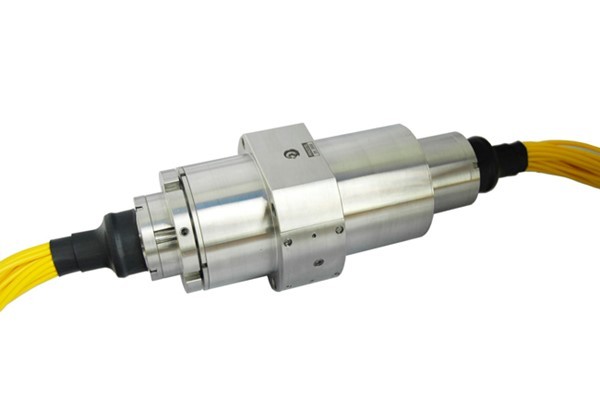
FORJs are slip rings designed to transmit optical signals used in certain data and telemetry applications. Best suited in scenarios where there’s a need for high-speed data transmission over a crane’s rotating parts.
Hybrid Slip Rings
Hybrid slip rings can transmit power, signals, and other mediums such as hydraulic or pneumatic fluids all in one unit. This type of slip ring is often used on more complex cranes that require the movement of fluids as well as electrical transmission.
Common Types of Slip Rings and Their Specifics
Pancake Slip Rings
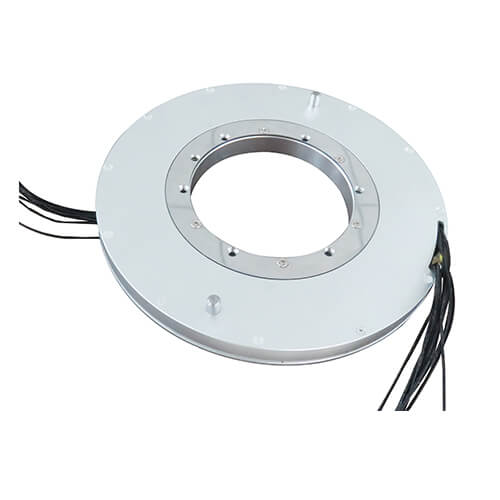
These slip rings are flat and round, hence the name. They are suitable for applications where the length is a critical factor, and there is ample space to accommodate their width.
Capsule Slip Rings
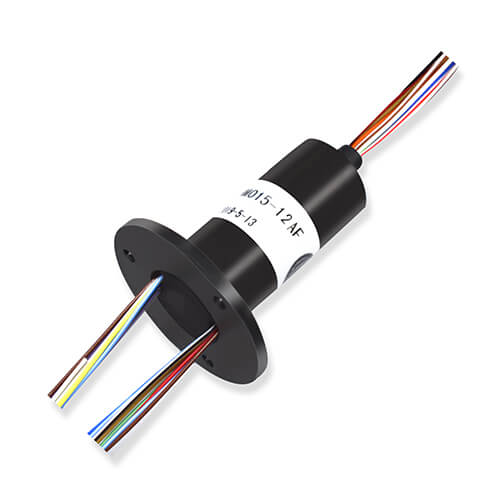
These are compact slip rings designed for systems with limited space. However, they may have limited circuitry due to their compact design. Frequently used in CCTV systems, they can be employed in specific crane applications where space is a significant concern.
Through-Bore Slip Rings
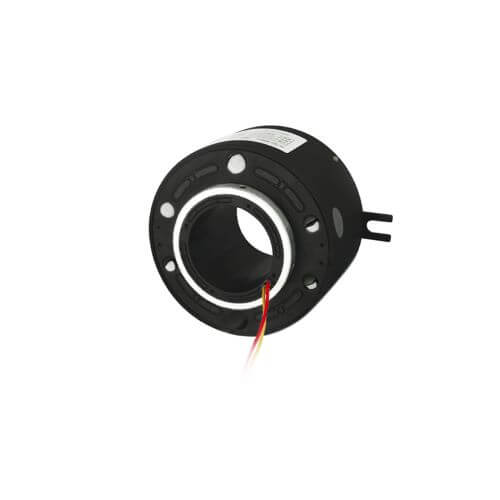
These slip rings have a hole (bore) in the middle, allowing additional components such as shafts, other cables, or even hydraulic lines to pass through. They are useful for applications where different systems need to run concurrently, aligning well with complex crane requirements.
Mercury Wetted Slip Rings
These slip rings, instead of using metal brushes, use a small pool of liquid mercury that the rotating part dips into, ensuring contact. The use of mercury reduces noise and wear, providing a stable and consistent connection. It’s essential to note that these are rarely used in marine cranes due to mercury being a hazardous material.
Understanding different types of slip rings, their features, compatibility, and potential applications can direct apt selection based on the crane’s requisites. With the correct type of slip ring in use, marine cranes can operate efficiently, safely, and continuously, tackling challenging maritime environments.
Marine Crane Slip Rings: Crucial Design Specifications
The design of marine crane slip rings entails meticulous consideration of various factors, as these affect the efficiency, durability, and compatibility of slip rings with specific applications. Some of the crucial design aspects that need to be carefully evaluated are:
- Installation Space: When specifying a slip ring, it’s essential to assess the available space for installation within the crane structure. This is vital to select the type and size of the slip ring that would comfortably fit and function without hindrances. Size constraints may necessitate a capsule, pancake, or through the bore slip ring, depending on the design requirements.
- Working Environment: The environment in which the slip ring functions determines the necessary measures to ensure its durability and operational performance. Marine cranes are exposed to harsh, corrosive air, high humidity, and varying temperatures, which can affect slip ring connectivity and stability. Designing for the protection and robustness of slip rings and the type of materials used plays a vital role in their longevity and efficiency.
- Number of Circuits: The number of circuits required must be determined while designing a slip ring. This is important as the slip ring needs to accommodate a specific number of electrical connections independently and without interference. Identify how many circuits are necessary for different functions, such as power, data, and hydraulic control, to ensure these needs are met by the slip ring design.
- Voltage & Current: Each slip ring needs to account for the voltage and current it is designed to handle. Higher voltage and current requirements necessitate specific design changes, such as the size of the rings, brushes, and the insulation material used. The design must prevent overloading or short-circuiting, thereby maintaining reliable functionality and ensuring safety in operation.
- Signal Type: For signal and data transmission, the type of signals the slip ring will be transmitted is a crucial parameter. Analog and digital signals can behave differently, and their requirements may vary in terms of circuitry design, contact materials, and shielding. For high-speed data transmission requirements, opting for a fiber optic rotary joint may be more suitable.
- Protection Rating: The degree of protection against solid particles and liquids offered by the slip ring enclosure is denoted by its Ingress Protection (IP) rating. Marine crane environments demand slip rings with a high IP rating to maintain reliable functionality. Evaluating the enclosure material and seals used in the slip ring is crucial to ensuring the design meets the required protection standard.
In summary, carefully considering these key design aspects and addressing their challenges is paramount in the development of a slip ring tailored for marine cranes. By ensuring the design accommodates installation space, specific environmental concerns, circuit requirements, voltage and current handling, signal types, and protection rating, the resulting slip ring can significantly contribute to enhancing crane performance, reliability, and longevity in harsh marine conditions.
Installation of Marine Crane Slip Rings
Installation of marine crane slip rings is a significant process that directly impacts their performance, durability, and safety. Below are the steps one may follow in the installation process.
Step-by-step Guide on the Installation Process
- Preparation: Begin by ensuring you have the correct slip ring model for your crane. Cross-verify the mechanical and electrical specifications with those outlined in your crane’s manual. You should also collect the necessary tools and personal protective equipment required for the installation.
- Disconnect Power: Before starting the installation, ensure that the crane or any associated equipment has been powered off and appropriately tagged out to prevent accidental powering up during the installation process.
- Remove the Existing Slip Ring: If you’re replacing an old slip ring, carefully disassemble it. This may require disconnecting wires plugged in it, loosening the screws and bolts that secure it, and sliding it off from its mounted position.
- Install the New Slip Ring: Position the new slip ring, ensuring it aligns correctly with the mounting brackets or clamps. Tighten the screws or bolts until they’re secure, but don’t overtighten them as it may damage the mounting or the slip ring.
- Connect the Wiring: Consult the slip ring manual or wiring diagram for this step. Ensure each wire is correctly terminated to the corresponding terminal in the slip ring. Secure the wire connections and make sure they’re appropriately insulated.
- Test the Installation: After everything is securely connected, perform a functionality test. This would involve powering up the crane and verifying that the operational behavior corresponds correctly to the control instructions.
Common Issues During Installation and How to Prevent Them
Even with proper care, issues may arise during installation. Understanding these common problems can help prevent them:
- Incorrect Specifications: One of the biggest mistakes that can occur is using the wrong slip ring for your crane. This can be avoided by thoroughly checking the specifications of your crane and ensuring they match the specifications of the slip ring.
- Poor Wire Connection: This can lead to inconsistencies in power or signal transmission. Make sure the wires are correctly oriented, connected, and secured to prevent this issue.
- Damage During Installation: Damage can happen due to various reasons – you might accidentally drop the ring, overtighten a screw/bolt, or mishandle the wires. Being mindful during installation and using the correct tools can avoid these problems.
- Incomplete Instructions: Missing or incorrect instructions can lead to improper installation and potential malfunctioning or shorting. To prevent this, always refer to the slip ring’s user manual or consult a professional.
In summary, installing marine crane slip rings correctly is vital to ensure their longevity and efficient operation. It requires careful adherence to the crane and slip ring specifications and a disciplined approach to follow the instructions. Once installed correctly, slip rings can profoundly enhance the functionality and safety of crane operations.
Maintenance of Marine Crane Slip Rings
Effective maintenance plays a crucial role in preserving the functionality and longevity of marine crane slip rings. Proper cleaning procedures, understanding possible maintenance issues, and acknowledging the importance of regular checkups are vital components in maintaining these critical components.
Proper Cleaning and Maintenance Instructions
Regular cleaning and maintenance are critical to keep the slip ring operational and extend its lifespan:
- Visual Inspection: Regularly inspect the slip ring for signs of wear, corrosion, and damage. Ensure the housing is free of leaks, and the connections are secure.
- Cleaning the Rings and Brushes: Proper maintenance includes cleaning the rings and brushes, usually done with a lint-free cloth soaked in a mild, non-conductive cleaning solvent. Avoid using abrasive materials or techniques that could damage the surface of the rings or brushes.
- Lubrication: Some slip rings may require occasional lubrication to minimize wear on the brushes and rings and ensure smooth rotation. Use the lubricants recommended by the manufacturer.
- Component Replacement: Worn-out brushes or damaged rings should be replaced immediately to prevent further damage or loss of operation.
- High-level Maintenance: For extensive maintenance or repair, it may be best to consult with a professional technician or return the slip ring to the manufacturer.
Common Maintenance Issues and Their Solutions
Encountering maintenance issues is not uncommon. Recognizing these problems and knowing how to solve them is key to continuous operation:
- Abrasion or Corrosion: Saltwater can lead to corrosion, while sand or dust can cause abrasion, affecting the slip ring’s performance. Regular inspection and frequent cleaning can help identify and address these issues early on.
- Excessive Wear: Over time, brushes and rings may show signs of wear. Regular inspection and timely replacement of worn-out components can prevent sudden failure.
- Intermittent Signal: This can be caused by contamination or wear on the rings or brushes. Cleaning or replacing these parts will resolve this issue.
- Electrical Surges: Surges can damage the slip ring’s components. If frequently occurring, identifying the source of the surge and implementing appropriate protective measures is recommended.
Importance of Regular Maintenance for Longevity and Efficient Performance
Regular maintenance of your slip ring is vital for maintaining optimal performance and extending its lifespan. Regular inspections can identify potential issues such as wear, corrosion, or damage early on, preventing expensive repairs or replacements.
Regular cleaning reduces the risk of signal loss or power surges, providing consistent and reliable operation. Additionally, the routine replacement of worn-out parts can vastly improve the lifespan and performance of your slip ring.
Hence, implementing a regular maintenance schedule and following through with necessary cleaning or repairs won’t just maximize the efficiency of your marine crane slip ring but also ensure a long and serviceable lifespan, contributing substantially to the continued operation of your marine crane.
Marine Crane Slip Rings: Troubleshooting
Marine crane slip rings represent a crucial link in the operation of cranes. Reliable performance depends on their stable operation and the swift resolution of any arising issues.
Common Issues and Their Fixes
Here are a few frequent problems that might occur, along with their potential fixes:
- Intermittent Signal: An intermittent or inconsistent signal can signal a need to clean or replace the contacts. If this fails to solve the problem, it might indicate extreme wear and require expert intervention.
- Excessive Noise or Vibration: This might indicate problems with the ring-brush contact. Inspect the system for signs of wear or debris and make the necessary corrections. In cases where this doesn’t resolve the problem, professional assessment is recommended.
- Elevated Temperature: Overheating could be a sign of overload or inadequate ventilation. Check the load on the slip ring and ensure it’s within the stipulated limits. If the temperature remains high, consider reinstalling the ring in a better-ventilated location.
- Corrosion: Saltwater environments can exacerbate corrosion. Regular cleaning and protective measures, such as using anti-corrosion coatings, are essential in preventing this problem. If significant corrosion has occurred, it may be necessary to replace affected parts or the entire slip ring.
When to Seek Expert Help
Although minor issues can often be remediated with simple cleaning or adjustment, more complex problems might require expert assistance. Here are a few situations when it’s recommended to seek professional help:
- Persistent Signal Interruptions: If you’ve cleaned and checked the rings, brushes, and wiring, yet signal issues persist, it could denote more complex issues that warrant professional attention.
- Major Component Failure: Mechanical or electrical failures, often due to wear or damage, need an expert’s repair or replacement.
- Recurrent Overheating: If the slip ring continuously overheats even after checking the load and improving ventilation, a professional assessment is advised.
- Frequent Breakdowns: If your slip ring is frequently breaking down despite regular maintenance, expert consultation can help diagnose whether it’s a problem related to design, compatibility, or environment.
Proactive troubleshooting and maintenance of marine crane slip rings will ensure their longevity and reliable performance. However, while some issues can be fixed in-house, more complex matters often require the knowledge and skills of a professional. By recognizing when expert intervention is necessary, you can ensure the best care for your slip rings and avoid costly and repetitive damage.
Choosing the Right Marine Crane Slip Rings
Selecting the correct slip ring for your marine crane is vital for a smooth, efficient operation and minimized maintenance downtime. This process requires careful consideration of several factors, including the quality of the product, the type of technology used, brand reputation, pricing, and the service and support offered post-sale.
Factors to Consider When Buying a Slip Ring
When exploring your options for marine crane slip rings, consider the following factors:
- Quality: Look for slip rings that are designed to withstand harsh marine conditions, such as saltwater corrosion and heavy wind loads. High-quality slip rings will operate consistently and have a longer lifespan, reducing the need for regular repairs.
- Technology Used: Make sure the slip ring uses robust technology that aligns with your operational requirements. Some may use fibre optics for high data transmission rates, while others focus on robust power transmission.
- Brand Reputation: Investigate the manufacturer’s reputation in the marketplace. Look for positive customer testimonials, reviews, and industry recommendations. A well-established and highly-regarded brand is more likely to produce reliable, high-performing slip rings.
- Pricing: While cost is an important consideration, it should not compromise the quality, reliability, or suitability of the slip ring. Balance the upfront cost with potential long-term savings due to lower maintenance and longer lifespan.
- After-sales Service and Support: Prioritise manufacturers offering dependable post-purchase support, including thorough installation guides, maintenance instructions, and accessible customer service for troubleshooting or repair queries.
Tips for Making the Right Choice
Following these tips can help make the best choice for your marine crane:
- Understand Your Requirements: Know your crane’s mechanical, electrical, and environmental specifications. Choose a slip ring that best suits these needs.
- Research: Dedicate ample time to researching different brands, slip ring types, and customer reviews to make an informed decision.
- Ask for Professional Advice: If you are unsure, engage with industry professionals, colleagues, or consultants to learn about their experiences and recommendations.
- Keep Future Needs in Mind: Select a slip ring that can accommodate future expansions or modifications to your system.
- Choose Quality Over Price: Opt for a high-quality, durable slip ring, even if the upfront cost is higher. It will likely result in less maintenance and longer service life.
- Consider Service and Support: Ensure the manufacturer provides excellent after-sales service, which will be invaluable for maintenance or troubleshooting needs.
Choosing the right slip ring for marine cranes is an important decision. By carefully considering the necessary factors and making informed choices, you’ll enhance the productivity and lifespan of your crane operations.
Marine Crane Slip Rings: Innovative Developments and Future
Technological advancements are revolutionizing the maritime industry, with marine crane slip rings being no exception. As ships, cranes, and other marine equipment continue to evolve to meet the growing needs for speed, safety, and efficiency, the slip rings that facilitate their functionality also need to keep pace.
Recent Technological Developments in Marine Crane Slip Rings
Several recent developments are reshaping the landscape of marine crane slip rings:
Fibre Optic Rotary Joints (FORJs)
One of the most significant advancements in slip ring technology, FORJs provide the ability to transfer large volumes of data reliably and quickly, allowing them to cater to advanced onboard systems.
Contactless Slip Rings
Utilizing magnetic fields or radio frequencies to transmit power and data, these slip rings eliminate physical contact between brushes and rings, reducing wear and increasing the lifespan of the device.
Enhanced Material Technologies
Innovations in material sciences have allowed the development of robust, corrosion-resistant slip rings, essential for the harsh marine environment.
Integrated Slip Rings
Some manufacturers now offer integrated solutions, combining rotary joints for fluids, gases, and electricity within a single device, saving both space and installation time.
Predictions for the Future
As the maritime industry continues to innovate and incorporate more digitalization and automation, certain trends are likely to shape the future of marine crane slip rings:
- Increasing Data Transmission: As the use of high-bandwidth applications like real-time monitoring, remote control, and AI increases in the maritime industry, slip ring technology will need to evolve to facilitate higher data transmission rates.
- Improved Durability and Resistance: Future slip rings must be equipped to withstand extreme conditions, aiming to reduce maintenance efforts, increase reliability, and extend lifecycle.
- More Integration: As manufacturers strive to simplify installation and maintenance, expect to see more integrated slip rings combining multiple functionalities in one device.
- Smart Slip Rings: As the IoT trend proliferates, enabling slip rings with sensors to monitor their own performance and remotely report maintenance needs are anticipated.
- Greener Technologies: With a growing emphasis on eco-friendly maritime practices, the development of slip rings with less power loss, thereby reducing energy consumption, can be expected.
The future of marine crane slip rings is likely to be defined by more significant, rapid technological advancements. These evolutions, driven by innovation and the industry’s need for improved efficiency, reliability, and data transmission capabilities, promise a fascinating future for marine crane slip rings.
Conclusion
In this guide, we delved deep into the world of marine crane slip rings, understanding their key role in crane operation. We highlighted common problems linked to these components such as intermittent signals, elevated temperatures, and corrosion, and delineated their solutions. As for purchasing a new slip ring, we emphasized the importance of various factors like the type of technology used, brand reputation, quality, pricing, and post-sales services.
Advancements like Fibre Optic Rotary Joints (FORJs), Contactless Slip Rings, Enhanced Material Technologies, and Integrated slip rings have been key in the recent evolution of slip ring technology. The future likely holds increased data transmission capacities, improved durability, the emergence of more integrated and smart slip rings, and greener solutions. Careful selection and maintenance are crucial in ensuring that marine crane slip rings operate with efficiency and longevity.
FAQs about Marine Crane Slip Rings
Below are some frequently asked questions about marine crane slip rings that further illuminate their importance and complexities:
Q: What is the purpose of a slip ring in a marine crane?
A: A slip ring is a critical component of a marine crane, enabling the transmission of electrical power and digital signals across rotating interfaces. This allows the crane to continually rotate while maintaining its operational capabilities, aiding in the process of loading and offloading cargo from ships.
Q: How can I maintain the performance of my marine crane slip ring?
A: Routine maintenance is key to the performance and lifespan of your marine crane slip ring. Cleaning the contact surfaces, inspecting for wear and tear, and performing regular functional tests are some ways to ensure optimal performance. Also, adhering to the manufacturer’s maintenance guidelines is important.
Q: When should I replace my slip ring?
A: The need for replacement can be determined by a variety of indicators such as excessive noise and vibration, high temperatures, or a significant decrease in performance. Regular maintenance and inspections can help anticipate the time for replacement. However, each case varies, and getting professional advice is recommended.
Q: What is a contactless slip ring?
A: A contactless slip ring is a device that utilizes magnetic fields or radio frequency to transmit power and data without any physical contact. This reduces wear and can significantly increase the lifespan of the device.
Q: What future advancements should I anticipate in marine crane slip rings?
A: Future advancements will probably focus on supporting higher data transmission rates, improving durability and resistance to harsh conditions, and greater integration of functions within a single device. The trend for smart slip rings, equipped with sensors to monitor performance and maintenance needs, is also likely to grow.
See What We Can Do

